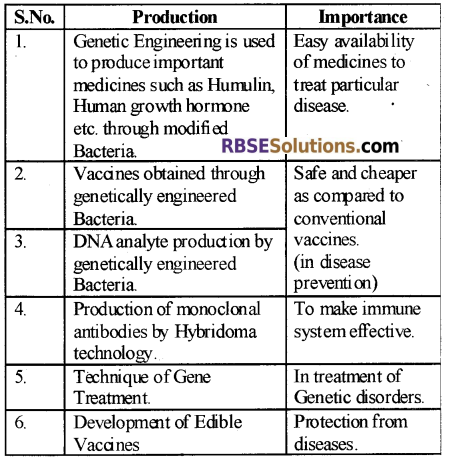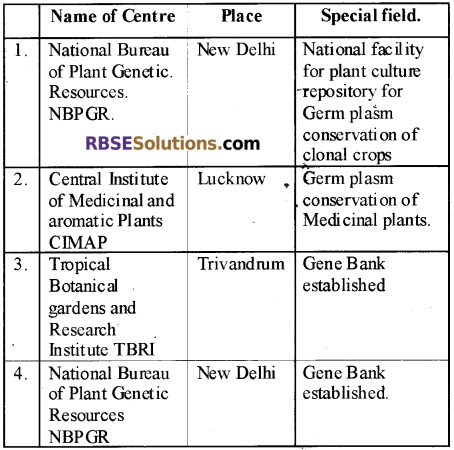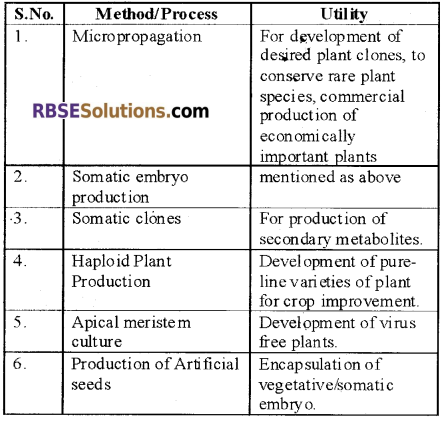Rajasthan Board RBSE Class 12 Biology Chapter 14 Biotechnology: General Introduction
RBSE Class 12 Biology Chapter 14 Multiple Choice Questions
Question 1.
Which of the following is not an example of Traditional Biotechnology?
(a) Formation of curd and cheese from milk
(b) Formation of vinegar from sugarcane juice
(c) Medicine production by rDNA technology
(d) Production of beer from sugar
Answer:
(c) Medicine production by rDNA technology
Question 2.
Who first of all used the word “Biotechnology”?
(a) Alexander Flemming
(b) Karl Erik
(c) Haberlandt
(d) Shipra Guha Mukherjee
Answer:
(b) Karl Erik
![]()
Question 3.
In which year National Biotechnology Board was established in India?
(a) 1982
(b) 1978
(c) 1986
(d) 1990
Answer:
(a) 1982
Question 4.
Centre for Cell and Molecular biology is situated at –
(a) New Delhi
(b) Hyderabad
(c) Poone (Pune)
(d) Chandigarh
Answer:
(b) Hyderabad
Question 5.
ICGEB is associated with which organization –
(a) NBTB
(B) UNIDO
(C) IARI
(d) ICFRE
Answer:
(b) UNIDO
Question 6.
Name of the first clone of sheep produced by Ian Wilmut is?
(a) Mouli
(b) Dolly
(c) Poly
(d) Jolly
Answer:
(b) Dolly
![]()
Question 7.
Who discovered Bacteriophage?
(a) Theodor Eschrich
(b) Antony Von Leeuwenhoek
(c) K.F. Budareh
(d) Frederich W. Wort
Answer:
(d) Frederich W. Wort
RBSE Class 12 Biology Chapter 14 Very Short Answer Questions
Question 1.
Define Biotechnology.
Answer:
Biotechnology is the subject of science which deals with the study of techniques dealing with the use of organisms and their functions for the betterment of life. In simple words, the use of microbes especially the bacteria, unicellular animals and plants, different cells, their components and various bio functions in producing useful products for human welfare, is called biotechnology.
Question 2.
What do you understand by traditional Biotechnology?
Answer:
In ancient time, our ancestors used to produce wine, beer, vinegar, bread etc. by the process of fermentation. The study of bioprocess related to fermentation and biological control is called traditional biotechnology.
Question 3.
Differentiate between classical (traditional) and modern biotechnology.
Answer:
- For fulfilling the need of life human have been producing various food products by use of fermentation, selecting crop plants, developing livestock and obtaining their products. This is called traditional biotechnology.
- Plant and animal tissue culture, genetic engineering, r-DNA technology, nanotechnology, production of monoclonal antibodies, etc. are the techniques used presently for human welfare and this is called modern biotechnology.
Question 4.
Define Biotransformation.
Answer:
Conversion of bio-products of relatively less utility into high utility products by the use of single-cell culture technique is called biotransformation.
![]()
Question 5.
What do you understand by Biotechnology Park?
Answer:
Biotechnology parks are the centres which provide information and counselling to the group of people who want to establish a biotechnology-based industry. In India, 19 such centres have been established and more are proposed to be set up.
Question 6.
What is Gene chip?
Answer:
These are microchips on which complementary DNA probes are established on an inert surface. These are able to identify the samples used for analysis or experimentation. These are also called DNA chips.
RBSE Class 12 Biology Chapter 14 Short Answer Questions
Question 1.
Write Notes on:
- ICGEB
- Biochips
- Biosensors
- Biofilm
- Microarray
- Department of Biotechnology
- Biotechnology Park
- Biotechnology Institutes in India
- Application of Biotechnology in Medicine
- Important Biotechnology Parks in India
- Important schemes of Biotechnology Department
Answer:
1. ICGEB:
International Centre of Genetic Engineering and Biotechnology. Considering the importance of biotechnology United Nations Industrial Development Organisation (UNIDO) established ICGEB in 1983 in New Delhi.
2. Biochips:
- Biochips are also called as DNA chips or DNA microarray.
- Biochip is a collection of small DNA molecules immobilised to a solid surface.
- This technique is used by scientist to measure the level of expression of several genes at one time.
- Stephen P.A. Fodor and colleagues (1991) developed the first biochip.
- The main substrate used in biochip is made of silica quartz, soda glass, and plastic etc. These are selected on the basis of their chemical structure, physical properties and as per the requirement of the experiment.
- Gene Chips – These are microchips on which complementary DNA probes are pasted and are able to identify the samples used for experimentation.
- Microarray – The microarray is of the following type:
- DNA microarray – The size of DNA microarray is even smaller than the postal stamp. Approximately 4 lakh cells are immobilised on inert (glass) surface. In each cell, there is found a micro spot of DNA. In each microspot, single-stranded cDNA (complementary DNA) sequence of different genes is found.
- Protein microarray – Protein microarray is a technique based on group binding analysis. It depends upon the products formed as a result of interaction between the target molecules present in the solution and the immobilized molecules.
3. Biosensors:
- All organisms contain biosensor which has functional system resembling mechanical devices.
- Biosensors are products of biological components (such as tissues, microbes, cell organelles, receptors, enzymes, antibodies nucleic acids etc.) which interact in different ways with the analyte.
- Thus biosensors are a mixture of biomaterials which transform the chemical and biological stimulus into an electric signal with the help of transducers.
- Blood sugar detector is an example of a commercial biosensor which breaks or digests blood sugar with the help of glucose oxidase enzyme.
4. Biofilm:
- A biofilm is a group of microbial cells adhered to each other and immobilized on a surface. This complex is normally covered by a matrix made up of polysaccharides.
- Thus biofilm is made up of microbial cells and extracellular polymer substances (EPS). Biofilms may be formed in a natural or modified environment.
- Biofilm functions as a basic unit in wastewater treatment and processes such as a sudden change in the quality of water etc.
5. Microarray:
Microarray is of two types:
- DNA microarray:
DNA microarray is of the size of a postal stamp. Approximately 4 lakh cells are immobilized on inert (glass) surface. In each cell, there is found a micro spot of DNA containing single-stranded C-DNA sequence of different genes. - Protein microarray:
Protein microarray is based upon group binding analysis. It depends upon the products formed as a result of interaction between the largest molecules present in the solution and the immobilized molecules.
6. Department of Biotechnology:
Considering the importance of biotechnology, Govt. of India established an independent department named as Department of Biotechnology in the year 1986. The main objective of this department is to develop basic infrastructure and facility in the field of biotechnology in different universities and institutes of repute for research in this field.
7. Biotechnology Park:
In our country, a total of 19 Biotechnology parks has been established to provide information and counselling to the group of people who want to establish biotechnology-based Industries. Considering the importance of the field of biotechnology, fifteen more biotechnology parks are in consideration for the establishment
8. Biotechnology institute in India:
- Indian Institute of Sciences – Bangaluru.
- National Bureau of Plant Genetic Resources NBPGR – New Delhi.
- A national facility for plant Tissue culture, Repository – New Delhi
- Central Institute of Medicinal and Aromatic Plants – CIMAP Lucknow
- Tropical Botanical Gardens and Research Institute – TBRI – Trivandrum.
- Rajeev Gandhi Biotechnology Centre – Thiruvananthapuram.
- International Centre of Genetic Engineering and Biotechnology (ICGEB) – New Delhi.
9. Application of Biotechnology in Medicine:
In Modern time, use of biotechnology is highly important in the medicinal field. Various efforts and experimentation done in the field of medicinal biotechnology are presented in the following table:

10. Important biotechnology Parks in India:
- Biotechnology Park, Lucknow, Uttar Pradesh.
- Hyderabad Biotechnology Park, Hyderabad, Andhra Pradesh.
- Golden Jubilee Biotech Park. (Biotechnology park) for women, Siruserri, Kanchipuram, TamilNadu.
- Guwahati Biotechnology Park, Assam.
- Biopharma-IT Park Andharuwa, Bhubneshwar.
- TICL International Biotechnology Park, Hinjawadi, Pune.
- KINFRA Biotechnology Park, Kerala.
11. Important schemes of the biotechnology department:
Department of biotechnology aims to develop institutes and centres for germplasm storage, conservation and re-establishment and started many schemes in this field as follows:
- National Bureau of Plant Genetic Research.
- National Facility for plant tissue culture repository.
- Central Institute of Medicinal and Aromatic Plants.
- Tropical Botanical Gardens and Research Institute.
![]()
Question 2.
Write the names of different branches of biotechnology.
Answer:
The main branches of biotechnology are as follows:
- Plant biotechnology
- Animal biotechnology
- Food and nutrition biotechnology
- Medical biotechnology
- Bioresource and environmental biotechnology
- Marine biotechnology.
- Bioinformatics biotechnology
RBSE Class 12 Biology Chapter 14 Essay Type Questions
Question 1.
Write a note on the development of Biotechnology in India?
Answer:
Bio-Technology in India:
- In our country, extensive research is going on in the field of biotechnology in various national and international institutes of repute and universities.
- Considering the importance and role of biotechnology in human welfare, Government of India established “National biotechnology Board”-NBTB in 1982.
- Initially, it was under the Department of Science and Technology, Government of India but looking into the importance of biotechnology independent department named as Department of Biotechnology (DBT) was established in 1986.
- The main objective of this department is to develop basic infrastructure and facilities in the field of biotechnology research in national and international institutes and in universities, establish specific research institutes and provide a grant in aid for their development.
In India, the following are specific centres for research in the field of biotechnology:
- Indian Institute of Science-Bengaluru-Genetic Engineering.
- Madurai Kamraj University, Madurai.
- Bose Institute, Kolkatta.
- Jawahar Lal Nehru University, New Delhi.
- Delhi University, Delhi.
- Poona University, Pune (Animal Cell Culture and Virology).
- National Chemical Laboratory, Pune (Plant Tissue Culture).
- Indian Agriculture Research Institute, New Delhi (Plant Tissue Culture, Photosynthesis, Plant molecular biology and Agriculture Information Sciences).
- Centre for Cell and Molecular Biology, Hyderabad (Oncogene, Cell transformation, Nucleic acid and Protein Structure).
- Natural Immunological Research Institute, New Delhi Research on Immunity.
- Microbial biotechnology institute:
Enzyme engineering Department of Biotechnology has established eleven information distribution centres and fifty subcentres in different institutes and universities. The main objective of these centres is to provide help to the institutes, groups and scientists working in the field of science. Presently these centres and subcentres are providing training relating to techniques of bioinformatics through workshops.
Note: Institutes established by Department of Biotechnology for germplasm storage, conservation and reestablishment.

- On these centres, seed, field bank and plant tissue culture repository and cryopreservation facilities are also desired.
- The universities, research centres and institutes, established and funded by the department of biotechnology are doing basic research in the field of medical biotechnology, food and nutrition, bioenergy, bioresources and environment, aqua biotechnology, aquaculture and marine biotechnology etc.
- Considering the importance of biotechnology, Rajeev Gandhi Biotechnology Centre was established in Thivanantpuram, Kerala and International Centre of Genetic Engineering and Biotechnology (ICGEB) was established in New Delhi by United Nations Industrial Development Organisation (UNIDO) in 1983.
Question 2.
Write about various techniques of Biotechnology.
Answer:
The main techniques used in the field of biotechnology are as follows:
- Plant and animal tissue culture.
- Plant and animal genetic engineering.
- Production of monoclonal antibodies.
- Recombinant DNA technology.
- Embryo transfer in Animals.
- DNA Nanotechnology.
Question 3.
Write a short note on various Institutes of Biotechnology and their contribution.
Answer:
Bio-Technology in India:
- In our country, extensive research is going on in the field of biotechnology in various national and international institutes of repute and universities.
- Considering the importance and role of biotechnology in human welfare, Government of India established “National biotechnology Board”-NBTB in 1982.
- Initially, it was under the Department of Science and Technology, Government of India but looking into the importance of biotechnology independent department named as Department of Biotechnology (DBT) was established in 1986.
- The main objective of this department is to develop basic infrastructure and facilities in the field of biotechnology research in national and international institutes and in universities, establish specific research institutes and provide a grant in aid for their development.
In India, the following are specific centres for research in the field of biotechnology:
- Indian Institute of Science-Bengaluru-Genetic Engineering.
- Madurai Kamraj University, Madurai.
- Bose Institute, Kolkatta.
- Jawahar Lal Nehru University, New Delhi.
- Delhi University, Delhi.
- Poona University, Pune (Animal Cell Culture and Virology).
- National Chemical Laboratory, Pune (Plant Tissue Culture).
- Indian Agriculture Research Institute, New Delhi (Plant Tissue Culture, Photosynthesis, Plant molecular biology and Agriculture Information Sciences).
- Centre for Cell and Molecular Biology, Hyderabad (Oncogene, Cell transformation, Nucleic acid and Protein Structure).
- Natural Immunological Research Institute, New Delhi Research on Immunity.
- Microbial biotechnology institute:
Enzyme engineering Department of Biotechnology has established eleven information distribution centres and fifty subcentres in different institutes and universities. The main objective of these centres is to provide help to the institutes, groups and scientists working in the field of science. Presently these centres and subcentres are providing training relating to techniques of bioinformatics through workshops.
Note: Institutes established by Department of Biotechnology for germplasm storage, conservation and reestablishment.

- On these centres, seed, field bank and plant tissue culture repository and cryopreservation facilities are also desired.
- The universities, research centres and institutes, established and funded by the department of biotechnology are doing basic research in the field of medical biotechnology, food and nutrition, bioenergy, bioresources and environment, aqua biotechnology, aquaculture and marine biotechnology etc.
- Considering the importance of biotechnology, Rajeev Gandhi Biotechnology Centre was established in Thivanantpuram, Kerala and International Centre of Genetic Engineering and Biotechnology (ICGEB) was established in New Delhi by United Nations Industrial Development Organisation (UNIDO) in 1983.
![]()
Question 4.
Describe the scope of different areas of Biotechnology and their importance.
Answer:
Scope and Importance of Biotechnology:
Human life is affected by biotechnology directly or indirectly. We can say that the scope of work in the area of biotechnology is very vast ranging from microorganisms to environment and ultimately human welfare. Following are different important areas related to human welfare and environment conservation related to biotechnology.
1. In Medical Field:
In Modern time, use of biotechnology is highly important in the medicinal field. Various efforts and experimentation done in the field of medicinal biotechnology are presented in the following table:

2. In-Plant Biotechnology:
Biotechnology techniques are useful in a multiplication of plants, conservation, improvement of crops etc. For the production of desired metabolic products, some other techniques have been developed. Some of the important processes and their utility are mentioned in the following table:

3. In the field of Animal Biotechnology:
- Ian Wilmut and Co-workers from Russian institute Scottland were able to produce first mammalian clone by fusion of enucleated ovum of Scottish Black Face sheep and nucleus of a somatic cell of a six-year-old Finn Dorset sheep on 5th July 1956.
- Wilmut and co-workers gave official information of this through media on Feb. 22, 1997, and named this first mammalian clone as “Dolly”.
- This opened a new door in the field of animal cloning Up to now more than twenty animal clones with desired features have been developed.
4. In Production of Materials of Commercial Importance:
By the use of cell and tissue culture technique, several commercially important products such as alcohol, acetone, glycerol, different types of organic acids, vitamins, enzymes and by single-cell culture, antibiotics, biogas etc. are being produced by using transformation technique of cell culture, less useful products can be converted into more useful products.
5. In conservation of Environment:
- Selected and transformed strains of Bacteria are used in sewage treatment, detoxification of toxic effluents of industrial units and degradation of mineral oil etc.
- Pseudomonas putrid strain discovered by Anand Mohan Chakraborty and often called superbug car control almost three fourth of oil-pollution.